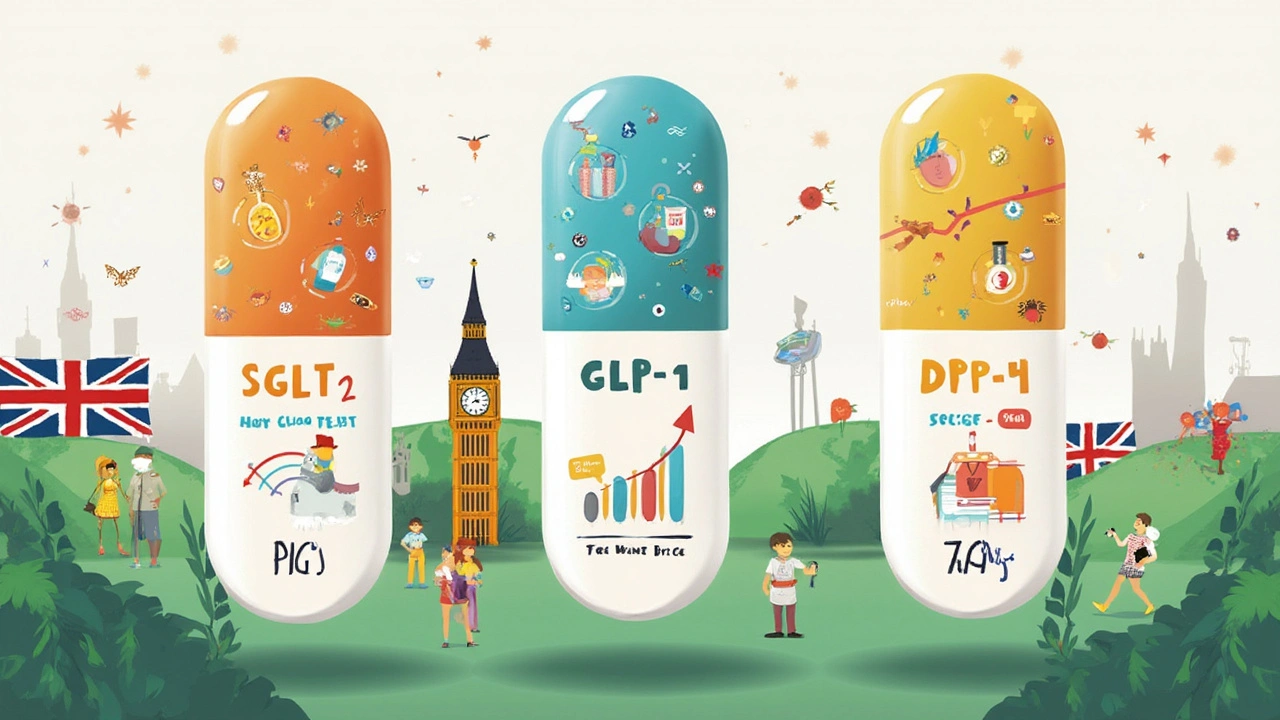Imagine waking up knowing your diabetes routine isn’t stuck in 1996. Most people taking glipizide have wondered: is this really the best option I’ve got, or should I level up to something new? Medicines move fast, and 2025 is no exception. The days when glipizide (actually discovered before the first Star Wars movie) was the only game in town are long gone. If you’re tired of dealing with low blood sugar scares, weird weight changes, or just want more predictable results, you’re not alone. So what’s replacing glipizide? Here’s your straightforward tour of the freshest oral diabetes treatments that could totally rewrite your diabetes story.
The Limits of Glipizide: Why Many Are Looking Elsewhere
Let’s get right to it—why are people even looking for glipizide alternatives? For decades, glipizide has been a staple for type 2 diabetes because it pushes the pancreas to pump out more insulin. The catch? You don’t want your insulin levels spiking at random or your blood sugar crashing at the worst time. The real-world problems: unpredictable hypos (especially if you skip a meal or exercise a bit harder), sometimes weird weight gain, and a feeling like your diabetes is driving you, not the other way around.
Recent Australian research found that nearly one in three glipizide users reported at least one hypoglycemic episode in the past year. For some, that’s a late-night shaky feeling; for others, it’s an actual dangerous event. Add to that, most GPs in Melbourne now try to avoid long-term sulfonylureas (the family glipizide belongs to) in people who’ve had even mild hypos or have jobs that require sharp thinking, like driving or working in construction. It’s not just about the lows—there’s growing worry about heart health and stroke risk, especially in older folks, and the possibility that sulfonylureas might not work as well after several years.
So if glipizide is so touchy, why is it still prescribed? Cost, mostly. It’s cheap and gets A1c numbers down… for a while. But newer meds are now on the PBS (Pharmaceutical Benefits Scheme) in Australia, so those logical reasons for staying on glipizide are fading away. Many doctors use it as a stepping stone and then shift patients over to newer options—if they can. For the latest deep-dive comparison, check out this guide to glipizide alternatives that shows seven real-world substitutes.
SGLT2 Inhibitors: Fewer Hypos, Surprising Perks
Enter SGLT2 inhibitors—these are the cool kids on the block these days. They work by making your kidneys filter out extra sugar through your urine. No, you don’t notice anything weird, but you do see your blood sugar creep down. They've really taken off in the past few years for three big reasons: low risk of hypoglycemia, actual weight loss (not gain), and bonus protection for your heart and kidneys. Seriously, how many diabetes pills do you know that also cut your chances of needing dialysis one day?
The heavyweights in this class are dapagliflozin (Farxiga in the US, Forxiga here in Oz), empagliflozin (Jardiance), and canagliflozin (Invokana). They’re typically once-a-day, safe with metformin, and don’t require meal planning gymnastics. Side effects? It’s mostly extra trips to the loo at first, and a slightly higher risk of urinary tract and yeast infections, especially if you’re prone to those. But you almost never see the rollercoaster highs and dangerous lows that happen with glipizide.
Here’s a snapshot from a real-world study published in The Lancet last year. Adult patients in a Melbourne clinic switched from glipizide to empagliflozin averaged an A1c drop of 1.1% over six months, lost around 2.3kg, and could cut their blood pressure meds. That’s not just doctor-speak—that’s real people being able to eat out without planning their meals to the gram. The protections against heart failure and kidney decline are now so well-proven that cardiologists and nephrologists often recommend SGLT2s even before an endocrinologist does.
SGLT2 inhibitors are PBS-listed, so costs aren’t as wild as they used to be. Some GPs are even switching patients straight from glipizide to SGLT2s once basic tests are clear (they’ll check kidney function, for sure). Oh, and here’s a quirk: drinking a bit more water in the first few weeks can help your body get used to excreting more sugar, making side effects less annoying.

GLP-1 Agonists: Not Just for Injections Anymore
GLP-1 agonists used to be the territory of weekly jabs, but 2025 is different. Semaglutide is now available as a daily oral tablet (Rybelsus), and more options are coming. These drugs work by mimicking a hormone that tells your pancreas to release insulin only when needed and slows down your stomach emptying, making you feel fuller for longer. You’ll hear about these in weight-loss circles, but for type 2s, it’s all about better A1c and a lower risk of heart problems.
The numbers are impressive. A big trial in Sydney in early 2024 looked at patients who swapped from glipizide to oral semaglutide. Not only did the majority see A1c drops averaging 1.2% (yeah, higher than with SGLT2s) but nearly half lost more than 4kg over 12 months. And here’s the magic: almost zero hypoglycemia cases unless paired with insulin or sulfonylureas. So you get steadier sugars *and* a little weight loss on the side. GLP-1s also drop heart attack and stroke risk in folks with a history of heart disease.
Newer pills like oral semaglutide take some planning—take it on an empty stomach, wait 30 minutes before eating, and don’t skip it. Not perfect, but easier than hauling needles everywhere, and it’s turning heads among busy Aussies who used to avoid GLP-1s because of the injection hassle. Side effects? Nausea is common early on, but it tapers off in most people within weeks. Rare but serious side effects include pancreatitis, but the rates are barely more than the background rate seen in non-users.
| Drug Class | Average A1c Reduction | Weight Change | Hypoglycemia Risk | Cardio-Kidney Protection |
|---|---|---|---|---|
| Glipizide (Sulfonylurea) | 1-2% | +1-2kg | High | No |
| SGLT2 Inhibitors | 1-1.2% | -2-4kg | Low | Yes |
| GLP-1 Agonists (Oral) | 1-1.4% | -3-6kg | Low | Yes |
| DPP-4 Inhibitors | 0.8-1% | Neutral | Low | Some |
Hot tip: If you’re struggling on glipizide and can feel your weight creeping up, a chat with your doctor about moving to an oral GLP-1 could check off a few big diabetes worries at once.
DPP-4 Inhibitors: The Middle Ground That Still Makes Sense
If SGLT2 inhibitors and GLP-1s are the flash new tech, then DPP-4 inhibitors are like the trusty sedan—steady, not too fancy, but rarely disappoint. Sitagliptin (Januvia), saxagliptin, linagliptin, and alogliptin are the main players. These work by blocking a chemical that would normally break down GLP-1 in your gut, so your body’s own insulin responses last longer after meals.
Why pick these? They don’t cause hypos (unless you pile them on top of sulfonylureas or insulin), and they’re weight-neutral. The blood sugar drops aren’t as dramatic as with SGLT2s or GLP-1s, but for many people, especially those who can’t tolerate other classes, DPP-4s still get the job done. You don’t have to worry about kidney function as much with linagliptin, which is safe in all stages of kidney disease—a huge relief for older Aussies. They’re simple: just a daily pill, no crazy dietary rules or bowel side effects like you might see with metformin’s early days.
DPP-4s tend to be gentler on your wallet, PBS-listed, and can piggyback with metformin or SGLT2s if needed. Don’t expect dramatic weight loss or big heart/kidney perks—though there’s some data sitagliptin can lower early-stage heart failure rates. They’re often the choice for folks who are slim and don’t need to lose weight, or are close to target A1c but just need a nudge down.
Worth knowing: you rarely see side effects beyond a slight chance of nose/throat irritation. Joint pain was flagged a few years ago, but it’s pretty rare—not something most people ever notice. Linagliptin is now offered in combination tablets with metformin or even SGLT2s, so you can cut your pill count if that’s your thing.

Tips for Choosing the Right Glipizide Alternative in 2025
The options can get overwhelming. How do you sift through the choices and figure out what’ll work for your life, not just your numbers? Here are the questions that matter most, straight from what’s working for real people in Melbourne and what doctors are discussing in clinics right now:
- What’s your biggest hassle with glipizide? Some want more stable blood sugars, others need to stop the weight gain. Pinpoint your pain point first.
- Do you have any history of hypos, heart, or kidney issues? If yes, SGLT2s or GLP-1s might be a strong pick because of their extra protection.
- How much does weight matter for you? Nearly half of GLP-1 users see meaningful weight drops, and SGLT2s help there too. DPP-4s don’t move the scales, but they won’t add kilos either.
- How often can you remember to take medicine? Most new options are once-a-day, but oral GLP-1s need to be taken precisely before eating—consistency pays off.
- Any tricky side effects with older meds? Nausea is the big one with GLP-1s, while SGLT2 users should keep good hygiene to avoid yeast infections.
One last tip: Check whether your chosen alternative is PBS-listed and what your copay will be. Cost shouldn’t lock you out of the best care, but it’s smart to ask your pharmacist in advance before the scripts hit your inbox. If your diabetes team isn’t up to speed with the latest options (happens in some regional clinics), push for a referral or share the latest research with them—you’d be surprised how many doctors are open to suggestions from switched-on patients now that more data is available.
Want to see the up-to-date shortlist, brand names, and user tips? This glipizide alternatives guide rounds up the top substitutes worth asking about and where each one shines in daily life. There’s never been a better time to take control of your A1c without locking yourself into the old-school rollercoaster.


Chris Meredith
Wow, this breakdown of oral diabetes meds is really on point!
Glipizide has been a staple for ages, but the novel classes like SGLT2 inhibitors, GLP-1 receptor agonists, and DPP-4 inhibitors are showcasing some seriously exciting mechanisms of action.
For example, SGLT2 inhibitors enhance glycosuria, effectively reducing plasma glucose pharmacokinetically, differing fundamentally from sulfonylureas.
But, with these newer agents, we're also seeing cardiovascular benefits, weight loss, and reduced hypoglycemic risk, which are huge clinical pluses for patients who might have struggled on glipizide.
However, it's crucial to consider the pharmacodynamics individually and match patients according to their comorbidities and lifestyle.
Personally, I think this move towards tailored medicine is a game-changer, allowing us to optimize A1c management smarter, not just harder.
Has anyone tried these newer classes firsthand, and what's your take from a symptomatic and side effect angle?